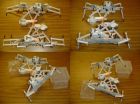With chemical modification, stable RNA nanoparticles go 3-D
2011-01-21
(Press-News.org) CINCINNATI—For years, RNA has seemed an elusive tool in nanotechnology research—easily manipulated into a variety of structures, yet susceptible to quick destruction when confronted with a commonly found enzyme.
"The enzyme RNase cuts RNA randomly into small pieces, very efficiently and within minutes," explains Peixuan Guo, PhD, Dane and Mary Louise Miller Endowed Chair and professor of biomedical engineering at the University of Cincinnati (UC). "Moreover, RNase is present everywhere, making the preparation of RNA in a lab extremely difficult."
But by replacing a chemical group in the macromolecule, Guo says he and fellow researchers have found a way to bypass RNase and create stable three-dimensional configurations of RNA, greatly expanding the possibilities for RNA in nanotechnology (the engineering of functional systems at the molecular scale).
Their results, "Fabrication of Stable and RNase-Resistant RNA Nanoparticles Active in Gearing the Nanomotors for Viral DNA Packaging," are published online at journal ACS Nano.
In their work, Guo and his colleagues focused on the ribose rings that, together with alternating phosphate groups, form the backbone of RNA. By changing one section of the ribose ring, Guo and his team altered the structure of the molecule, making it unable to bind with RNase and able to resist degradation.
"RNase interaction with RNA requires a match of structural conformation," says Guo. "When RNA conformation has changed, the RNase cannot recognize RNA and the binding becomes an issue."
While he says previous researchers have shown this alteration makes RNA stable in a double helix, they did not study its potential to affect the folding of RNA into a three-dimensional structure necessary for nanotechnology.
After creating the RNA nanoparticle, Guo and his colleagues successfully used it to power the DNA packaging nanomotor of bacteriophage phi29, a virus that infects bacteria.
"We found that the modified RNA can fold into its 3-D structure appropriately, and can carry out its biological functions after modification," says Guo. "Our results demonstrate that it is practical to produce RNase-resistant, biologically active, and stable RNA for application in nanotechnology."
Because stable RNA molecules can be used to assemble a variety of nanostructures, Guo says they are an ideal tool to deliver targeted therapies to cancerous or viral-infected cells:
"RNA nanoparticles can be fabricated with a level of simplicity characteristic of DNA while possessing versatile structure and catalytic function similar to that of proteins. With this RNA modification, hopefully we can open new avenues of study in RNA nanotechnology."
INFORMATION:
Guo serves as director of UC's National Institutes of Health (NIH) Nanomedicine Development Center and Nanobiomedical Center. This work was funded by grants from the NIH.
Co-authors include Jing Liu, Mathieu Cinier and Yi Shu from UC, Chaoping Chen from Colorado State University, Guanxin Shen from Huazhong University of Science and Technology in China, and Songchuan Guo from Kylin Therapeutics, Inc.
END
ELSE PRESS RELEASES FROM THIS DATE:
2011-01-21
RUSTON, La. – While most people were busy shopping during the holiday season, Dr. Daniela Mainardi, associate professor of chemical engineering at Louisiana Tech University and member of the Institute for Micromanufacturing, was preparing for a trip that would take her half way around the world.
As part of a joint effort, Mainardi, together with Virendra Mathur from the University of New Hampshire, and Suddhasatwa Basu and Shantanu Roy from The Indian Institute of Technology-Delhi, was in charge of organizing a workshop titled, "Energy and Environment: Challenges and ...
2011-01-21
WASHINGTON, Jan. 20, 2011 — The latest episode in the American Chemical Society's (ACS) award-winning podcast series, "Global Challenges/Chemistry Solutions," focuses on development of a new ultra-light biodegradable foam plastic material made from two unlikely ingredients: The protein in milk and ordinary clay.
The material could be used in numerous products, researchers report in the ACS' Biomacromolecules, a monthly journal. The finding comes amid ongoing concern about plastic waste accumulating in municipal landfills, and reliance on imported oil to make plastics.
David ...
2011-01-21
LA JOLLA, CA – January 20, 2011 – Scientists at The Scripps Research Institute have found that a known enzyme in cells protects against measles virus, likely by altering the virus's genetic material, RNA. Cells lacking the enzyme become highly vulnerable to the virus's destructive effects. The enzyme also protects against several other respiratory viruses, including influenza A.
"We believe that host cells use this RNA-editing enzyme to slow these viruses' ability to replicate," said Michael B. A. Oldstone, the study's senior author and a professor at Scripps Research's ...
2011-01-21
Stanford, CA— Genghis Khan and his Mongol hordes had an impact on the global carbon cycle as big as today's annual demand for gasoline. The Black Death, on the other hand, came and went too quickly for it to cause much of a blip in the global carbon budget. Dwarfing both of these events, however, has been the historical trend towards increasing deforestation, which over centuries has released vast amounts of carbon dioxide into the atmosphere, as crop and pasture lands expanded to feed growing human populations. Even Genghis Kahn couldn't stop it for long.
"It's a common ...
2011-01-21
WASHINGTON, Jan. 20 – The eyes of moths, which allow them to see well at night, are also covered with a water-repellent, antireflective coating that makes their eyes among the least reflective surfaces in nature and helps them hide from predators in the dark. Mimicking the moth eye's microstructure, a team of researchers in Japan has created a new film, suitable for mass-production, for covering solar cells that can cut down on the amount of reflected light and help capture more power from the sun.
In a paper appearing in Energy Express (www.OpticsInfoBase.org/ee), a ...
2011-01-21
VIDEO:
A two-minute video, "Morphological Change in Machines Accelerates the Evolution of Robust Behavior, " was produced by the Morphology, Evolution and Cognition Laboratory, University of Vermont, 2011.
Click here for more information.
Want to build a really tough robot? Forget about Terminator. Instead, watch a tadpole turn into a frog.
Or at least that's not too far off from what University of Vermont roboticist Josh Bongard has discovered, as he reports ...
2011-01-21
AURORA, Colo. (Jan. 20, 2011)--Cancer scientists have designed the first molecular test to predict which bladder cancer patients may have cancer involvement in their lymph nodes at the time of surgery—which could help doctors determine which patients are good candidates for pre-surgical, or neo-adjuvant, chemotherapy.
The test analyzes 20 genes on tumor biopsies, according to a paper published online Jan. 20, 2011, in Lancet Oncology.
"Randomized clinical trials have shown that giving neo-adjuvant chemotherapy extends patient lives, but only 5 to 15 percent of patients ...
2011-01-21
In a paper published today in the journal Science, a University of California, Davis, researcher and his co-authors challenge a widely held assumption that plants will move uphill in response to warmer temperatures.
Between 1930 and 2000, instead of colonizing higher elevations to maintain a constant temperature, many California plant species instead moved downhill an average of 260 feet, said Jonathan Greenberg, an assistant project scientist at the UC Davis Center for Spatial Technologies and Remote Sensing.
"While the climate warmed significantly in this period, ...
2011-01-21
With little more than a conventional photocopier and transparency film, anyone can build a functional microfluidic chip.
A local Cambridge high school physics teacher invented the process; now, thanks to a new undergraduate teaching lab at Harvard's School of Engineering and Applied Sciences (SEAS), students will be able explore microfluidics and its applications.
The Microfluidics Lab, developed by Dr. Anas Chalah, Director of Instructional Technology at SEAS, takes advantage of a simple but ingenious new method of creating lab-on-a-chip devices that are quick to produce, ...
2011-01-21
DETROIT—Wayne State University researchers have found that when patients and providers speak the same language, patients report less confusion and better health care quality. The findings were based on data from the Pew Hispanic Center/Robert Wood Johnson Foundation's Latino Health Survey.
Understanding the relationship between language and health care quality has important public health implications for providing services in an increasingly diverse U.S. population, according to Hector M. González, Ph.D., assistant professor of family medicine and public health at WSU's ...
LAST 30 PRESS RELEASES:
[Press-News.org] With chemical modification, stable RNA nanoparticles go 3-D


